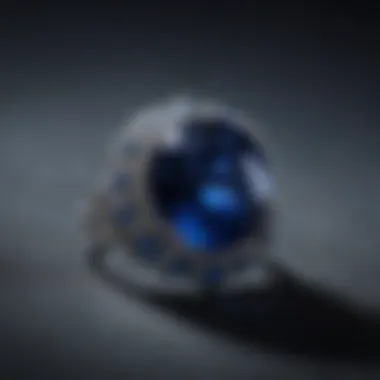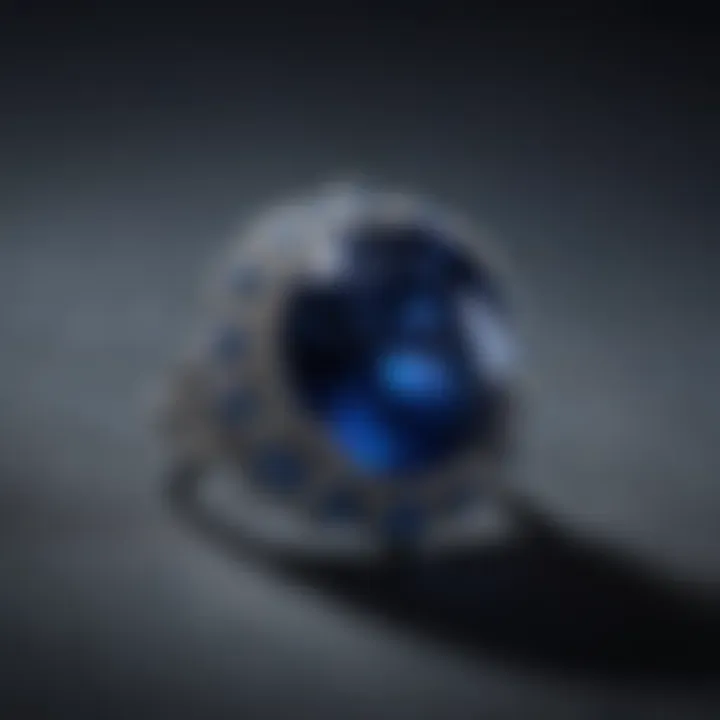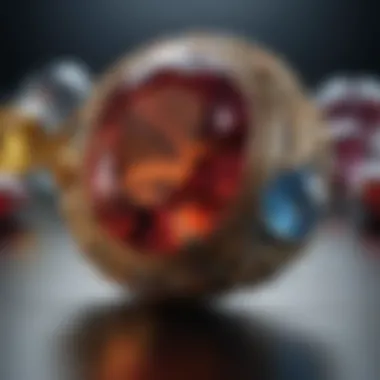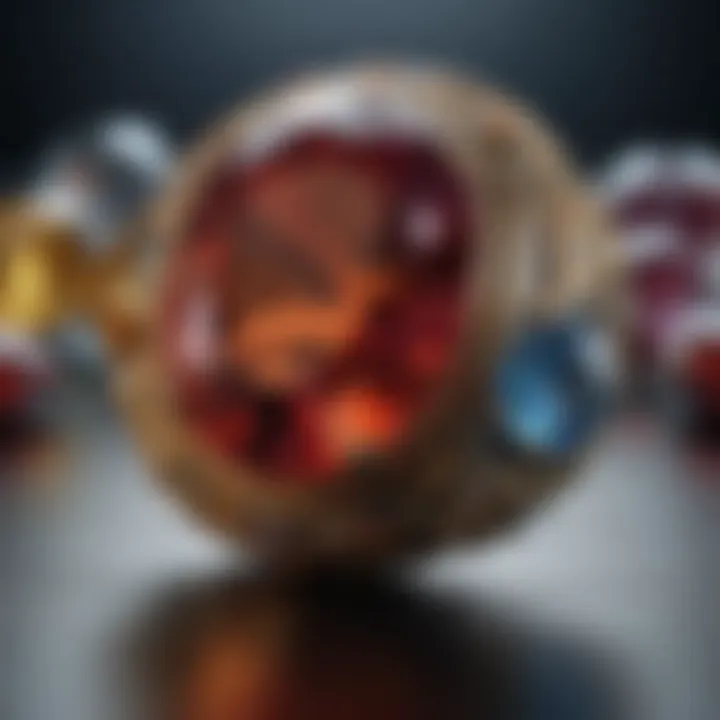The Vibrant Meanings Behind Birthstone Colors


Intro
The world of gemstones is rich with stories and meanings. Each gemstone, particularly birthstones, carries with it a unique set of qualities. These qualities are often tied to their colors, which provide insight into their historical and cultural significance. Understanding the connection between color and meaning enhances the appreciation for these beautiful stones. This article aims to delve into these intricacies.
Gemstone Overview
Definition and Origins
A birthstone is a gemstone that is traditionally associated with a person's month of birth. The belief in birthstones goes back centuries, with origins linked to the twelve stones mentioned in the Book of Exodus. Each of these stones symbolized a specific tribe of Israel. Over time, these gems became linked with astrological signs and individual months.
Historical Significance
Different cultures have ascribed various meanings to birthstones. For instance, the ancient Greeks and Romans wore these stones as talismans to protect them from harm. In the Middle Ages, birthstones gained popularity in Europe as they were believed to bring good fortune and health to the wearer. Each stone is not merely decorative but carries a legacy of superstition and tradition.
Gemstone Properties
Hardness and Durability
The hardness and durability of a gemstone are crucial factors in determining its value and use. The Mohs scale, which ranks minerals from 1 (softest) to 10 (hardest), is often employed to measure hardness. For instance, diamonds rank highest on this scale, making them highly sought after. Understanding these properties assist collectors in navigating market options.
Color and Clarity
Color is arguably the most defining attribute of any gemstone. It conveys beauty and influences emotional responses. Gemstones can exhibit a wide range of colors due to their chemical composition and internal structure. Clarity, on the other hand, refers to the transparency and presence of inclusions. The interplay between color and clarity affects not only the gem's aesthetic but also its market value.
Intro to Birthstones
Birthstones, with their vivid colors and rich narratives, have held a significant place in human culture for centuries. These gemstones are not merely decorative items; they embody a confluence of history, spirituality, and personal identity. Understanding the role of birthstones in our lives enhances their appreciation, making each gem a potent symbol that can resonate with individuals on multiple levels.
Historical Background
The concept of birthstones dates back to ancient civilizations, where they were thought to hold special powers. The twelve stones associated with the twelve signs of the zodiac are possibly the earliest references, traced back to the biblical era. Each stone was believed to carry protective and healing properties.
In the Bible, specifically in the Book of Exodus, the high priest's breastplate had twelve gemstones representing the tribes of Israel. This association established a strong cultural connection between colors and personal identity. As societies evolved, the tradition of birthstones transformed. By the 20th century, the modern list of birthstones was formalized by the American National Retail Jewelers Association in 1912, creating a tangible link to one’s birth month.
Cultural Significance
Cultural implications of birthstones are numerous and varied. Across different cultures, gemstones symbolize different traits and emotions. For instance, in ancient Egypt, turquoise was revered for its protection against evil spirits, while in medieval Europe, ruby was believed to symbolize passion and courage.
In contemporary culture, birthstones often serve as gifts for birthdays or significant life events. They are seen as a means of expressing love and dedication, making them popular choices for jewelry. Moreover, birthstones have practical utility; they can symbolize milestones in relationships or personal achievements, connecting physical beauty with sentiment.
Understanding the cultural weight of birthstones allows us to appreciate their meanings deeply. This blend of historical and cultural significance enhances the overall narrative of each gem, which will be explored further in this article.
"Each birthstone tells a story, woven through time and culture, waiting to be discovered by those who seek its wisdom."
The exploration of birthstones is not only about colors but also how these colors relate to human experiences, emotions, and spirituality. As we journey through the vibrant spectrum of gemstones, we will uncover the layers of meaning that each one encapsulates.
The Concept of Colors in Gemstones
Colors not only define the beauty of gemstones but also serve as key identifiers and bearers of meaning. When analyzing birthstones, understanding color is vital in enriching the knowledge of their significance. Each color contributes to the narrative surrounding the gemstone, affecting personal and cultural associations. Therefore, exploring the concept of colors in gemstones can deepen appreciation for these natural wonders and enhance the selection process for collectors and jewelry designers.
Color Theory and Perception
Color theory offers a framework for understanding how colors are perceived and classified. Colors can be categorized as primary, secondary, and tertiary. In gemstones, the primary hues include reds, blues, greens, and yellows. These colors are influenced by the minerals that form the stone and the impurities contained within. For example, the presence of chromium can render emeralds a rich green, whereas iron might give sapphires a deep blue.
The perception of color is also subjective and can vary between individuals and cultures. Psychological studies show colors can evoke emotions and influence thoughts. Therefore, the color of a birthstone does not only dictate its visual impact but can also affect the viewer’s mental state. For instance, blue is often associated with calmness and serenity, whereas red evokes excitement and energy.
Moreover, light plays a significant role in how colors are perceived. Gemstones like diamonds exhibit brilliance that can change based on the light conditions. This phenomenon is known as colorplay or fire, where light disperses into spectrum within the stone. The ability of a gemstone to reflect light adds to its allure, enhancing its value.
Impact of Color on Meaning
The implications of color extend beyond aesthetics; they are deeply entwined with symbolism and personal significance. Different cultures attribute unique meanings to various colors, which can influence how gemstones are received. For example, red in many cultures symbolizes love and passion, correlating with the ruby's symbolism of love and vitality.
- Cultural associations: In some traditions, colors are tied to specific attributes. Blue gemstones often represent wisdom and protection. This is noteworthy for sapphires, which have historically been associated with royalty and divine favor.
- Personal connections: Individuals may have personal preferences related to certain colors, linking them with memories or experiences. This connection can make specific birthstones more meaningful, as they reflect an individual's identity or life events.
- Industry standards: The jewelry industry also recognizes the significance of color in valuing gemstones. High-quality stones tend to have rich, saturated colors that are desirable in the market. Therefore, understanding the perceived value of a gemstone based on its color can inform purchasing decisions.
"The impact of color is not just a matter of aesthetics; it deeply involves emotions, culture, and personal connection."
January – Garnet
Garnet, the birthstone for January, holds a significant position in the world of gemstones. Its vibrant hues and rich history make it a topic of great interest for both enthusiasts and collectors. Garnet is renowned for its myriad of colors, which not only add aesthetic appeal but also influence its meaning and symbolism. This section will delve into the color variations of garnet and the underlying symbolism it carries.
Color Variations
Garnet is a versatile gemstone that comes in a range of colors. While most people associate garnets with a deep red shade, it is essential to recognize that this stone actually exhibits a broader spectrum. Some notable varieties include:
- Almandine: A deep red to violet-red variant, this garnet is perhaps the most recognized.
- Pyrope: This type offers a bright red hue, often likened to that of a ruby.
- Spessartine: Known for its orange to reddish-orange colors, spessartine garnets are less common but striking.
- Tsavorite: A vivid green variety, tsavorite garnets are prized for their lush color and rarity.
- Rhodolite: A purplish-red stone, rhodolite garnet is known for its brilliance.
The various colors of garnet stem from different mineral compositions and impurities within the stone. Each variation offers unique aesthetic qualities and can influence the buyer's choice depending on personal preference and significance.
Symbolism and Meaning
Garnet is rich in symbolism. Historically, it has been associated with various meanings across cultures. The most prevalent interpretations include:
- Protection: Garnet is believed to offer protection during travel and prevent accidents.
- Love and Passion: Its red hues symbolize deep emotions, particularly love and passion. Couples often gift garnet jewelry as a token of affection.
- Vitality and Energy: Garnet is said to revitalize energy and promote self-confidence.
- Healing: Some attributes garnet with the ability to alleviate emotional issues and promote balance.
"Garnet is not just a beautiful gemstone; it embodies deeper meanings that resonate with many individuals. Its rich history and vibrant appearance make it a topic of fascination for jewelers and spiritual seekers alike."
February – Amethyst
Amethyst, the birthstone for February, holds a particular place in the hearts of gemstone enthusiasts and collectors alike. Its stunning purple hues evoke a sense of calm and clarity, making it not only a favored choice for jewelry but also for spiritual purposes. This gemstone appeals to those interested in both aesthetics and meanings, enriching the understanding of its place in personal and cultural narratives.
Color Spectrum


Amethyst showcases a fascinating color spectrum that ranges from a delicate lavender to a deep, rich purple. The variations are noteworthy. The intensity of the color is determined largely by the iron content within the crystal structure during its formation.
Some pieces feature a lighter, almost pastel shade that can appear enchanting in sunlight. Others, with darker tones, present a regal presence, often favored in high-end jewelry designs. This versatility in color allows amethyst to be used in various contexts, from casual wear to formal settings. The stone's mesmerizing qualities are further enhanced by its translucence, which reveals depth and complexity in its color layering.
Properties and Interpretation
The amethyst is more than just a beautiful gem; it carries a wealth of properties and interpretations. Many believe that amethyst promotes tranquility and mindfulness. It is often associated with clarity of thought and is said to help in decision-making processes. Collectors appreciate its connotations of protection and purification, attributes that can resonate deeply with individuals on a personal level.
Other cultural interpretations highlight its use in ancient healing practices, suggesting that amethyst could enhance spiritual awareness and combat negative energy. Amethyst is also linked historically to royalty and luxury, often being found in crowns and regalia. The symbolism associated with its vibrant color—commonly linked to balance and peace—makes it a thoughtful choice for those seeking harmony in their lives.
"Amethyst's deep purple hue has captivated creators and collectors for centuries, symbolizing both beauty and purpose."
March – Aquamarine
Aquamarine, the birthstone for March, embodies qualities that resonate with clarity and calmness. Its alluring shades of blue reflect the essence of the sea, making it a stone of significant appeal for many gemstone enthusiasts. In this section, we will delve into the captivating shades of blue that Aquamarine exhibits, as well as the deeper meanings and influences this gemstone holds.
Shades of Blue
Aquamarine is primarily known for its range of blue colors, which can vary from pale sky blue to deep sea blue. The variations in shade are often influenced by the amount of iron present in the crystal structure. Generally, lighter tones are preferred for jewelry, as they evoke a sense of tranquility and serenity. When selecting Aquamarine, one should consider:
- Color Intensity: A more intense blue often signifies a higher quality stone.
- Clarity: Aquamarine is praised for its transparency, which enhances its beauty. Clarity contributes significantly to value.
- Cut: The way the stone is cut can impact how the color is perceived. Well-cut stones will reflect light more effectively, enhancing their color.
Understanding these shades can enhance the appreciation for Aquamarine as a stone that not only pleases the eye but also invites reflection and calm.
Meaning and Influences
Aquamarine is often regarded as a stone of courage. Its name derives from the Latin word for "water of the sea," hinting at its connection to emotions and the fluidity of feelings. This gemstone has a history rich with interpretations and meanings:
- Emotional Balance: Aquamarine is believed to help in soothing anxiety and evoking a sense of peace. It is often associated with calming waves.
- Communication: Known to enhance clarity in communication, many users find it helpful in discussing their feelings openly.
- Spiritual Growth: The stone is linked with meditation and spiritual awareness, allowing individuals to delve deeper into their thoughts and feelings.
"Aquamarine encourages self-expression and empowers the wearer to speak their truth with clarity."
This exploration of Aquamarine highlights its significance, ensuring that its beauty is appreciated on both aesthetic and emotional levels.
April – Diamond
The diamond is a symbol of many virtues. This gemstone is a birthstone for the month of April. Understanding the diamond's significance goes beyond its crystalline beauty. It carries rich associations due to its color variability and cultural interpretations. These facets contribute to the diamond being considered one of the most coveted gemstones worldwide.
Color Variability
Unlike traditional precious stones that maintain a single color, diamonds display remarkable variability. The most celebrated color of diamonds is clear, symbolizing purity and clarity of thought. However, diamonds come in an array of hues. These include shades of yellow, blue, pink, and green, each presenting its own significance.
- Clear Diamonds: Often symbolize unwavering love.
- Yellow Diamonds: Are linked with optimism and enlightenment.
- Blue Diamonds: Represent tranquility and peace.
- Pink Diamonds: Stand for compassion and romance.
Each variation affects perception towards the stone, influencing preference for collectors and enthusiasts. The color can enhance or alter meanings attributed to diamonds in various cultures.
Cultural Interpretations
Throughout history, diamonds have been wrapped in various cultural interpretations. They are often viewed as a mark of status and power. In many cultures, diamonds are a symbol of eternal love and commitment, thus making them a popular choice for engagement rings. The connection of diamonds to love finds roots in ancient Roman beliefs, where they were thought to be splinters of stars. This mythology adds an ethereal dimension to their allure.
In Eastern traditions, diamonds were believed to bring protection and success to their wearers. Various cultures have their unique perspectives on diamonds, and societal views influence how this gemstone is regarded in the market today.
"The diamond's multifaceted nature not only captivates but also unites diverse interpretations across cultures, from pure love to potent protection."
Such richness in meanings makes diamonds fascinating for both casual admirers and serious collectors. It is essential for gemstone enthusiasts to appreciate those subtleties in interpretation. Understanding this will enhance their knowledge and admiration for this remarkable stone.
May – Emerald
Emerald, the birthstone for May, is a significant gem that holds a special place in the history and culture of gemstones. This particular stone is well-known for its striking green color and its association with various positive attributes. Its importance in this article lies not only in its aesthetic appeal but also in the depth of meaning and heritage attached to it. The rich green hues are captivating, but they also serve as a symbol of growth and renewal. The association of emeralds with prosperity and fertility makes it an essential gemstone to explore in-depth.
Rich Greens
The primary color of emerald is green, yet this green can vary significantly in shade and intensity. From bright, vivid greens to deeper, more subdued tones, the color of each emerald can tell a different story. This variability comes from the presence of trace elements, particularly chromium and vanadium, which influence the gem's coloration.
Emeralds are often classified based on their color tone. Here are some common categories:
- Vivid Green: This is the most desirable shade, often associated with the highest quality emeralds.
- Bluish-Green: A hue that carries a hint of blue, giving the stone a different look.
- Yellowish-Green: Less sought after, this color can dilute the gemstone's value.
Each shade is unique and can affect both the gem's market price and its symbolism. The rich greens of the emerald are not just attractive but also evoke feelings of tranquility and balance. This is particularly important for collectors and enthusiasts who appreciate the nuances in color when choosing their stones.
Meaning and Heritage
Emeralds have long been regarded as powerful stones steeped in history. Ancient civilizations, including the Egyptians and the Incas, revered this gem for its beauty and believed it held mystical powers. Known as the stone of fertility and renewal, emerald has been thought to bring reason and wisdom to its wearer. Its association with the heart emphasizes healing and emotional balance, which resonate deeply with those who prize personal growth and enlightenment.
In terms of cultural influences, emerald is often linked to the following:
- Faithfulness: Many cultures see emeralds as symbols of loyalty and love. They have been used in wedding and commitment jewelry for centuries.
- Protection: Various traditions speak of the emerald as a protective stone, keeping negativity at bay and promoting harmony.
- Status: Throughout history, emeralds have adorned the crowns of royalty, symbolizing power and prestige.
As a gemstone in modern contexts, emeralds continue to hold significance. Their allure remains timeless. Collectors and enthusiasts alike often seek emeralds for both their stunning visual qualities and their rich lineage. Ultimately, the emerald captures a unique blend of beauty and meaning, making it a prominent focus within the context of birthstones.
Emeralds exemplify the intersection of nature's artistry and human history—a stone that is as vibrant as it is profound.
June – Pearl
Pearl, the birthstone for June, is unique in many aspects, making it a significant topic in the discussion of gemstones. Unlike most gemstones, pearls form organically within oysters. This distinct origin imparts a natural beauty that has captured the fascination of collectors and jewelry designers alike. In this section, we explore the underlying tones of pearls and their symbolic resonance, illuminating their importance in culture and personal significance.
Underlying Tones
The color of pearls can vary greatly, but they primarily showcase soft white and cream tones. However, deeper analysis reveals a richness in subtler hues. Shades of pink, blue, and even green may surface depending on the oyster species and environment. The process of light interacting with the layers of nacre gives pearls their characteristic luster and depth, resulting in a multifaceted appearance.
- White Pearls: Commonly linked to purity and innocence, they find their place in bridal jewelry.
- Pink Pearls: These tones evoke feelings of calm and warmth.
- Black Pearls: Often associated with mystery and sophistication, they can symbolize strength.


Understanding these subtle tones helps collectors appreciate pearls more fully. Each shade carries its distinct energy and story, adding layers of meaning to any piece of jewelry.
Symbolic Resonance
Pearls have held significant meanings across cultures for centuries. Often seen as a symbol of wisdom and integrity, they can convey messages of emotional balance. Their organic nature connects them to the ocean’s depth and the mysteries of life.
"The pearl is the only gemstone that comes from a living creature, which gives it a special place in the world of gemstones."
In many traditions, pearls symbolize love and fidelity, often gifted during important life events such as weddings or anniversaries. Additionally, they are linked to the moon and its calming qualities, representing tranquility and enhancement of personal integrity. For some, wearing pearls can inspire feelings of deep connection to nature and one's inner self.
In sum, the importance of Pearl as a June birthstone reflects both aesthetic appeal and rich symbolism. Its diverse colors and meanings attract gemstone enthusiasts, collectors, and jewelry designers, making it a focal point in the study of birthstones.
July – Ruby
Rubies, as the birthstone for July, hold a significant position in both historical and contemporary discussions around gemstones. The rich red color associated with rubies makes them one of the most valued and sought-after gems in the world. Their importance transcends mere aesthetics, encompassing deep-rooted meanings that resonate with various cultures and traditions.
The ruby's vibrant hue captures the essence of passion, love, and energy. In many cultures, it is viewed as a stone of nobility, often linked to royalty and wealth. Beyond its beauty, the ruby is respected for its perceived abilities to promote vitality and protect the wearer. Understanding ruby's various shades of red and the associated symbolism can provide gemstone enthusiasts with essential insights into their appeal and significance.
Various Red Hues
Rubies are renowned for their unique shade of red. However, this red is not just a plain color; it consists of a spectrum ranging from pinkish reds to deep, blood-like crimson. The red color in rubies comes from chromium, and its intensity can vary depending on the mineral content and the conditions during formation.
- Pinkish Red: This hue represents softer emotions and feelings. It is associated with love and innocence.
- Medium Red: Often seen as the classic ruby color, it symbolizes courage and passion. This is the shade most commonly associated with rubies in jewelry.
- Dark Red: The darkest rubies, akin to blood, are typically highly valued due to their rarity. They represent power and protection, enhancing the gem's allure.
These variations not only impact the gem's value but also influence how those hues might be interpreted in art and design. Understanding these colors helps one appreciate the full depth and complexity of rubies.
Symbolism Behind Color
The color red itself carries substantial weight in both cultural and emotional contexts. Rubies symbolize love, passion, and desire, making them a popular choice for engagement rings and other romantic gifts. When presented as a gift, they convey strong emotions and commitment.
Cultural Symbolism: In many cultures, red is a color of luck and prosperity. In China, for example, red represents good fortune and joy, making rubies highly regarded in Chinese jewelry.
"The ruby is known as the king of gems, encompassing the fiery passion of the heart, and is often considered a stone of encouragement."
Healing Properties: Beyond personal significance, rubies are said to have healing properties. They are associated with stimulating the heart and circulatory systems, enhancing energy, and driving away lethargy. This connection to vitality reinforces their meaning as stones of life and love.
Ultimately, understanding the nuances of ruby's red colors and the meanings behind them can significantly enrich a collector's or enthusiast's appreciation for this powerful stone. The ruby stands not just as a beautiful piece of jewelry but as a timeless emblem of passion, strength, and emotional depth.
August – Peridot
Peridot is the birthstone for August and holds a special place in the world of gemstones. Its unique color and rich history contribute to its significance. The vibrant green hue of peridot not only captivates gemstone lovers, but it also carries deep meanings and implications. Understanding the distinct characteristics of this gemstone can inspire appreciation and consideration for potential buyers and collectors.
Distinctive Green Shades
The primary color associated with peridot is a bright green that can vary in intensity. This stone can present shades that range from yellowish-green to olive green. The most valued coloration is a vivid green, which often resembles the color of freshly cut grass. The unique green tones of peridot set it apart from other green gemstones, such as emerald or jade. Its clarity enhances its brilliance, allowing light to reflect beautifully within the stone.
Often, the hue of peridot is influenced by the amount of iron present during the formation process. The presence of more iron can deepen the color while a lower concentration results in lighter tones. Some consider a lighter shade of peridot to be less desirable, although beauty is subjective and personal preferences vary.
Meaning and Implications
Peridot carries various meanings that are steeped in history and culture. Historically, it has been associated with protection and healing. Some ancient civilizations believed peridot could ward off evil spirits and bring peace. Its green color symbolizes renewal, growth, and prosperity. Many people view it as a stone that encourages positive energy and emotional balance.
Moreover, the implications of possessing or wearing peridot can extend to relationships. It is thought to enhance communication and understanding among friends and partners, making it a fitting gift for loved ones.
"Peridot is not just a stone of beauty; it represents a vibrant connection to nature and personal growth."
Purchasing peridot jewelry can provide not only an aesthetic appeal but also emotional or spiritual attributes. Collectors often seek this gemstone for both its visual and symbolic qualities. In addition, the stone is relatively abundant compared to other gemstones, which can make it a more accessible choice for those interested in adding color to their collection without breaking the bank.
In summary, peridot stands out in the scope of birthstones due to its distinctive green shades and rich meanings. It connects to themes of growth, well-being, and vitality, making it more than just a piece of jewelry but rather a symbol of positive change.
September – Sapphire
Sapphires hold a prominent place among the birthstones, particularly for those born in September. This gemstone is cherished not only for its stunning appearances but also for its rich historical context and multifaceted meanings. The sapphire comes in a spectrum of colors, extending beyond the well-known blue that many associate with the stone. Understanding the various colors and their meanings can deepen the appreciation for this gemstone, making it a valuable topic for enthusiasts and collectors alike.
Variety of Colors
While often recognized for its deep blue hue, sapphire is available in a plethora of colors, making it a unique choice in the world of gemstones. Each color variation presents distinct emotional and symbolic meanings. For example, yellow sapphires often represent clarity of thought and specific creativity, while pink sapphires symbolize love and affection. Even green sapphires, which are less common, can represent harmony and balance.
Moreover, color impacts the market demand for sapphires. Color preference varies culturally, influencing collectors in different regions. Sapphires can transform in appearance under different lighting conditions, leading to varied perceptions of their true beauty. Collectors should be aware of these qualities when considering purchases, as they affect both aesthetics and value.
Cultural Significance
The cultural implications of sapphires stretch far across time and geography. In many cultures, sapphires are considered stones of protection, believed to bring peace and wisdom. Historical records suggest that ancient kings adorned their crowns with sapphires to symbolize divine favor and benevolence.
"In ancient Asia, sapphires were thought to attract heavenly blessings and are often used in religious contexts."
Modern interpretations of sapphires also reflect their perceived qualities of loyalty and nobility. In contemporary jewelry design, the sapphire is not only a popular choice for engagement rings, symbolizing eternal love, but also embodies the essence of wisdom and virtue.
Understanding the cultural significance of sapphires can enhance an individual's appreciation for this gemstone and guide their decisions in selection and gifting. For gemstone enthusiasts, the sapphire serves as a reminder of the rich heritage and stories that surround this remarkable stone.
October – Opal
Opal is the birthstone for October. The gem is known for its unique light-reflecting ability, giving it a spectrum of colors that can shift and change as the stone moves. This characteristic is what makes opal a captivating focus of study and collection. It stands out not only for its aesthetic appeal but also for its historical and cultural significance. The excitement around opal comes from its hues that range from vibrant blues and greens to soft pinks and yellows, each variation offering a different charm.
Color Play and Variance
The play of color in opal is one of its most distinctive features. Unlike many gemstones, opal does not have a consistent color and instead displays a shifting palette of colors due to its unique internal structure. This structure contains silicon dioxide spheres that diffract light, producing a phenomenon known as opalescence. Different types of opal exhibit various colors:
- White Opal: Exhibits a milky background with bright flashes of color.
- Black Opal: Features a dark background that enhances the play of colors, often seen in bright reds and oranges.
- Boulder Opal: Includes ironstone or sandstone in its matrix, leading to unique patterns.
The uniqueness of each opal stone makes it distinctive. No two opals are identical, which adds to its allure among collectors and jewelry designers. This color play not only engages the eye but also illustrates the fascinating properties of opal as a gemstone.


Symbolic Interpretations
Opal carries various meanings and interpretations across different cultures. Often associated with purity and hope, it symbolizes innocence and truth. In ancient times, opal was considered a powerful stone, believed to provide protection and enhance the inner light of the individual. In Rome, it was seen as a symbol of love and hope, while in the Middle Ages, it was reputed to have magical qualities, helping its wearer to gain foresight.
Contemporary beliefs hold that opal enhances creative expression and emotional stability. It is also thought to be a stone of inspiration, enhancing one's creative ventures. Collectors appreciate not only the color variations but also the rich traditions and meanings that opal has accumulated over centuries.
"Opal is not just about beauty; it embodies stories and legends that travel through time and cultures."
When considering the purchase of opal, factors such as origin, type, and color play an important role in its value. The enchanting appearance combined with its historical significance makes opal a valuable and meaningful gemstone for those born in October.
November – Topaz
Topaz holds a significant place among the birthstones, especially for those born in November. Known for its diverse range of colors and deep symbolism, Topaz is not only a beautiful gemstone but also carries a wealth of meanings across various cultures. Understanding Topaz's characteristics offers insight into its appeal for gemstone enthusiasts and collectors.
Color Range
Topaz is remarkable for its extensive color variations. The most recognized is the golden yellow shade, resembling the warm hues of autumn. However, Topaz can also present in shades of blue, pink, and even clear variants.
- Imperial Topaz: This rare type includes a golden to pink hue, often associated with luxury and wealth.
- Blue Topaz: Generally enhanced through treatment, this color ranges from pale to deep blue, symbolizing calm and tranquility.
- Pink Topaz: This rarer variant appeals to those drawn to softer colors and is often linked to romance and affection.
Each color communicates its unique message. For instance, blue Topaz might evoke serenity, while golden Topaz can represent optimism and joy.
Meanings Across Cultures
Topaz's significance can be seen globally, reflecting cultural beliefs and traditions. In ancient Rome, it was believed that Topaz protected its wearer from harm and provided strength. The stone was associated with Jupiter, the god of light. In contrast, in the Middle Ages, people thought Topaz brought wisdom and understanding. UNESCO even recognizes Topaz's historical importance, highlighting its usage in jewelry as a symbol of power.
Moreover, different cultures have attributed various meanings to Topaz:
- Hindu Tradition: In Hindu culture, Topaz is believed to bring good fortune and dispel negativity.
- Chinese Symbolism: In Chinese culture, it is linked with prosperity and wealth, often worn during important festivals.
These interpretations enhance Topaz's desirability among collectors and individuals who seek not only beauty but also depth in their gemstone choices.
December – Turquoise
Turquoise, one of the most ancient gemstones known to humanity, carries deep meaning and significance. It is the birthstone for December, a month often associated with celebration and reflection. This stone is revered not only for its unique colors but also for its historical and cultural importance. Understanding the characteristics of turquoise allows gemstone enthusiasts to appreciate its beauty and significance in various contexts.
Shades of Blue and Green
Turquoise is characterized by its vibrant shades of blue and green, which can vary significantly based on the mineral composition and the presence of copper and iron. The most highly sought-after hues are the bright, robin's egg blue and the deeper, more verdant shades. This color variation is not merely aesthetic; it ties into the gemstone's rarity and value.
The perception of turquoise's color can also evoke emotional responses. The calming blue often represents tranquility and peace, while the green hues tend to symbolize growth and renewal. Both colors have a unique allure, making turquoise a desired choice for jewelry and decorative items.
In addition to its visual appeal, turquoise can also carry meanings influenced by its shades. Lighter shades may resonate with feelings of calm and serenity, whereas darker shades often suggest stability and strength. Thus, the shades of turquoise contribute to its multifaceted character, making it not just a visual delight but also an emotionally significant gem.
Cultural Associations
Turquoise has been culturally significant across various civilizations. In ancient Egypt, it symbolized protection and healing and was often used in burial masks and jewelry for the pharaohs. Native American cultures consider turquoise a sacred stone, believed to hold protective qualities. It is often used in ceremonial attire and gifted during significant life events such as weddings and births.
Different cultures have their unique interpretations of turquoise's meaning. For example, in Persian culture, turquoise is associated with the sky and purity. The versatile nature of turquoise allows it to transcend cultural boundaries, becoming a unifying symbol in various traditions.
Overall, turquoise stands as a vibrant representation of the rich tapestry of human history and belief systems. Understanding its cultural associations enhances the appreciation of this beautiful gemstone, making it not just a mere ornament but a piece of heritage.
"Turquoise is more than just a color; it is an expression of time, culture, and emotion, woven into the very fabric of our history."
In summary, turquoise's allure lies not only in its captivating shades of blue and green but also in its deep-rooted cultural significance. For gemstone collectors and enthusiasts, turquoise offers a remarkable blend of beauty, meaning, and historical context.
Contemporary Interpretations of Birthstones
The modern understanding of birthstones goes beyond their historical roles and cultural significances. In today’s context, the interpretation of birthstones has evolved, reflecting contemporary values and lifestyles. The increasing desire for personal meaning and uniqueness has reshaped how people select and wear their birthstones. As a result, it is crucial to examine contemporary interpretations and understand their impact on gemstone enthusiasts and collectors.
Emerging Trends
Recent years have seen several emerging trends related to birthstones. One significant trend is the rise of customization. Many people seek personalized jewelry that incorporates their birthstones with other meaningful stones or designs. This approach enhances the emotional significance of the pieces. There is also a growing interest in alternative stones. Individuals are exploring birthstones outside the traditional list, often choosing stones that resonate more personally with them. For instance, individuals born in December may opt for tanzanite or zircon instead of the conventional turquoise.
Social media platforms play a vital role in spreading awareness of these trends. Platforms like Instagram and Pinterest are filled with inspiring jewelry designs and ideas. Collectors and enthusiasts use these platforms to showcase their unique collections, influencing others' choices.
Personal Significance
In addition to customization, the personal significance of birthstones has gained prominence. Today, birthstones are often viewed as more than just adornments. They hold profound meanings related to identity and emotional well-being. For many, their birthstone serves a reminder of their unique traits or aspirations.
Furthermore, people are increasingly incorporating birthstones into rituals or meaningful practices. They may carry their birthstones for protection or use them during meditation to enhance personal growth. This connection helps individuals tap into the deeper layers of meaning behind their gemstones.
As the appreciation of gemstones matures, what resonates with individuals becomes more important than traditional interpretations. Understanding personal meanings attributed to gemstones enhances their allure. It instills a sense of intimacy with one's choices. Ultimately, contemporary interpretations of birthstones reflect a mix of tradition, individuality, and personal exploration.
"The meanings attributed to birthstones today are shaped by personal choice, individuality, and cultural context. They are not limited to traditional definitions."
These emerging trends and personal significances highlight how birthstones continue to captivate and inspire individuals in new and profound ways.
End
The conclusion of this article encapsulates the intricate relationship between the colors of birthstones and their symbolic meanings. Birthstones hold significance not only for their physical beauty but also for the cultural and personal narratives they embody. Each gemstone carries specific traits tied to its color, which contributes to how people perceive them. Such understanding can influence choices made by gemstone enthusiasts, collectors, and jewelry designers. Recognizing these layers of meaning enhances the appreciation of these stones in various contexts, from personal adornment to investment.
Summary of Findings
Throughout this article, we examined the history and importance of birthstones within different cultures and periods. Each month brings forth a unique gemstone, reflecting a spectrum of colors that embody various characteristics:
- Garnet: Deep red, symbolizing love and passion.
- Amethyst: Purple, often linked to peace and clarity.
- Aquamarine: Blue, representing serenity and tranquility.
- Diamond: Colorless, signifying purity and strength.
- Emerald: Rich green, embodying hope and renewal.
- Pearl: Subtle, often associated with wisdom.
- Ruby: Vivid red, symbolizing vitality and confidence.
- Peridot: Light green, linked to prosperity and growth.
- Sapphire: Available in various colors, often associated with loyalty and nobility.
- Opal: Multi-colored, symbolizing creativity.
- Topaz: Varies in shades, often related to love and affection.
- Turquoise: Muted blue-green, conveying protection and healing.
This variety illustrates how the perception of color directly influences the meanings attributed to each stone. Embracing these interpretations allows for better personal connections and choices when selecting birthstones.
Future Directions in Gemstone Studies
As gemstone studies evolve, further research can expand on several aspects of birthstones:
- Cultural Interpretations: Additional cross-cultural studies could unveil lesser-known meanings linked to specific birthstones.
- Technological Advances: The application of technology in gemological research could offer deeper insights into the molecular properties that affect color.
- Market Trends: Investigating consumer behavior towards birthstones can empower both sellers and buyers, promoting sustainable practices amongst jewelers.
- Personal Resonance: Encouraging individuals to share personal stories about their birthstones could create a communal appreciation for these gems.
Ultimately, the world of gemstones is not just about aesthetic appeal but also about the rich stories they tell. Future studies will likely uncover even more fascinating insights into the colors and meanings of birthstones, enriching the knowledge base for enthusiasts and collectors alike.



